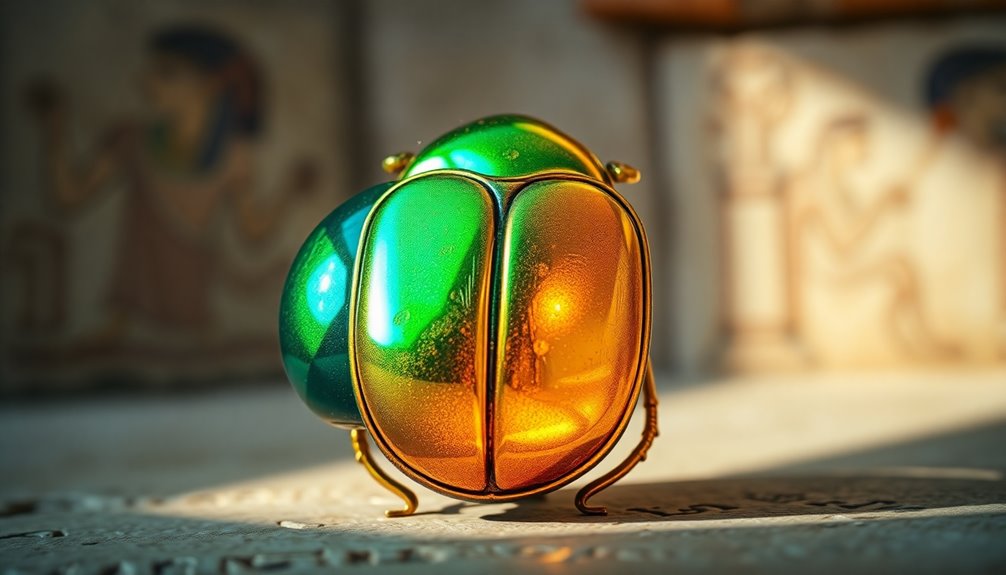The scarab symbol holds incredible power, representing rebirth and transformation in ancient Egyptian culture. You see, the scarab beetle, linked to the sun god Ra, rolls dung balls that symbolize the sun's journey across the sky. Historically, scarabs served as protective amulets in funerary practices, ensuring safe passage to the afterlife. Crafted with intricate designs, they embody authority and spirituality. Today, they remain popular in jewelry, symbolizing good luck and personal transformation. This timeless icon continues to inspire and connect you with its rich cultural heritage, with fascinating insights waiting for you to discover further.
Key Takeaways
- The scarab symbolizes regeneration and rebirth, embodying the life cycle associated with the sun god Ra in ancient Egyptian culture.
- Scarab amulets were used as protective tokens in funerary practices, ensuring safe passage to the afterlife for the deceased.
- Crafted from various materials, scarabs featured intricate designs and color symbolism, representing fertility, protection, and eternal life.
- Scarab rings historically served as personal tokens for pharaohs, believed to provide divine power and guidance through transformations.
- Today, scarab symbols are incorporated into modern jewelry trends, connecting individuals to ancient beliefs and serving as tokens of good luck.
Symbolism of the Scarab
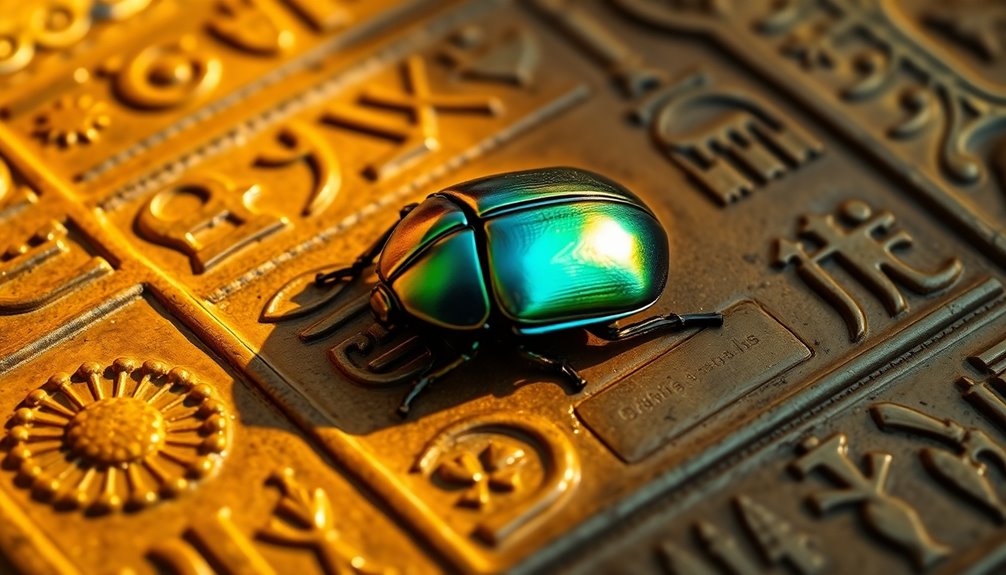
What makes the scarab such a powerful symbol in Ancient Egyptian culture? The winged scarab represents regeneration and rebirth, deeply intertwined with the sun god Ra and the natural cycle of life and death.
You'll notice that ancient Egyptians often depicted scarabs rolling balls of dung, symbolizing the sun's journey across the sky. This imagery captures the essence of transformation, a core principle in their worldview.
In funerary practices, scarabs served as protective amulets, believed to guide and safeguard the deceased on their journey in the afterlife. You can find scarab motifs in jewelry, tomb decorations, and architecture, reflecting the cultural values and religious beliefs of the time.
These artifacts not only showcase the artistry of the period but also signify the importance of the scarab in daily life and spiritual belief.
Dating back to the Old Kingdom period, scarab artifacts illustrate the evolution of design and symbolism across various dynasties in Ancient Egypt.
Historical Context and Usage
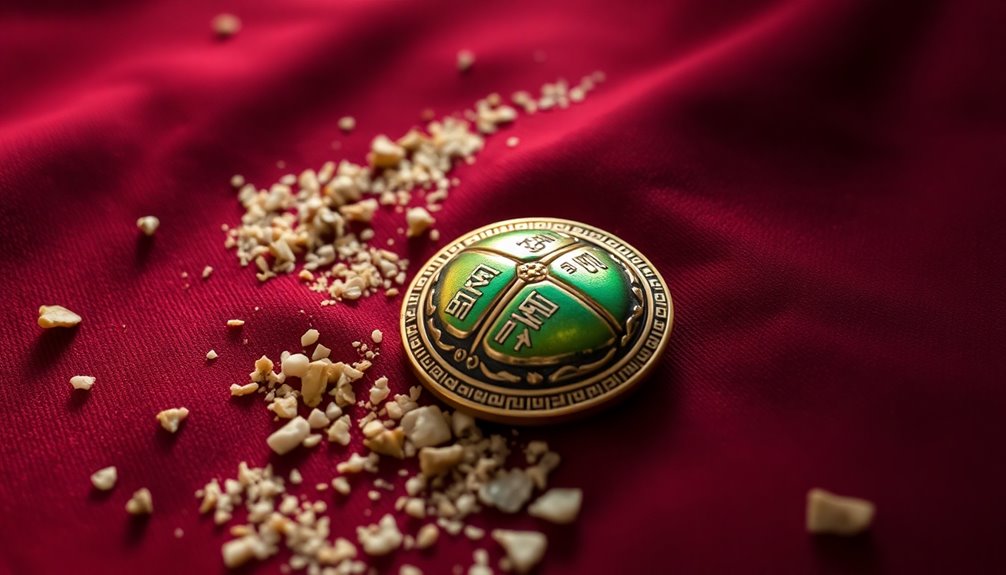
Emerging from the rich tapestry of Ancient Egyptian culture, scarab amulets played a crucial role in both daily life and funerary practices. These sacred symbols date back to the Old Kingdom period (c. 2686–2181 BCE) and evolved in design and significance through various dynasties. Scarabs were believed to provide protection and blessings, serving as indispensable tokens for the living and the deceased alike.
You'd find scarabs in various contexts:
- Tomb Inclusions: Often placed in tombs, scarabs accompanied the deceased to guarantee a safe journey into the afterlife.
- Seals and Security: Scarabs served as seals for important documents and jars, symbolizing authority and safeguarding valuable contents.
- Heart Scarabs: Typically inscribed with protective spells, these were placed on the chest of mummies to protect the heart during judgment.
Crafted from materials like steatite, carnelian, and faience, scarabs showcased the artistic skill of ancient Egyptian artisans. Their significance extends beyond mere decoration, reflecting deep cultural beliefs about life, death, and the afterlife.
In every aspect, scarabs held an unparalleled power in the lives of the ancient Egyptians.
Artistic Representation of Scarabs
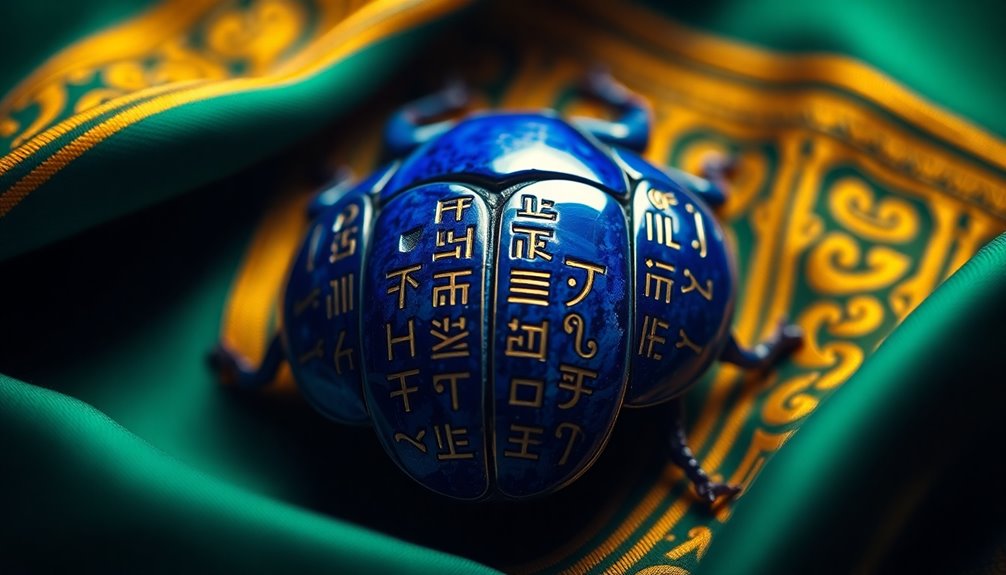
The intricate designs of scarabs reveal the remarkable artistry of ancient Egyptian jewelers, showcasing their skill and creativity. These scarabaeus sacer were crafted from various materials like stone, faience, and metal, highlighting the craftsmanship of their makers. Designs varied widely, ranging from simple to highly elaborate, often enhanced by hieroglyphics that carried names, prayers, or magical spells meant to protect the wearer or the deceased.
Color symbolism played a crucial role in the artistic representation of scarabs. Here's a glimpse into how colors and poses contributed to the scarab's meanings:
| Color | Symbolism | Pose |
|---|---|---|
| Green | Fertility | Resting |
| Blue | Protection and spirituality | Rolling dung balls |
| Red | Power | Flying |
| Yellow | Eternal life | Standing |
| Black | Resurrection | Crawling |
Each scarab's pose and color choice reflected deeper meanings, connecting the artistry of the piece to the spiritual beliefs of ancient Egypt. This remarkable blend of aesthetic and symbolism is what makes scarabs truly enchanting.
Scarab Rings and Their Significance
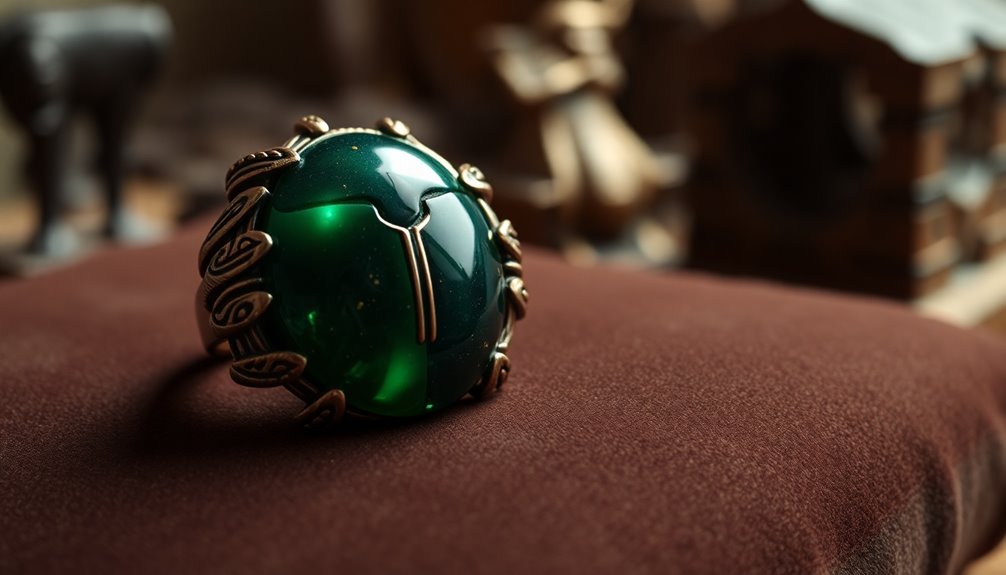
Worn on fingers throughout history, scarab rings hold deep significance as symbols of protection, rebirth, and change.
These rings embody the life cycle associated with the scarab beetle and its connection to the sun god Ra. Often worn as amulets, scarab rings were believed to provide divine power and guidance through life's transformations, making them essential for both the living and the deceased.
With their rich history, scarab rings carry multiple meanings:
- Protection: These rings were thought to shield the wearer from evil and misfortune.
- Rebirth: They symbolize the cyclical nature of life and the promise of renewal.
- Change: Scarab rings represent personal growth and evolution, reflecting the wearer's journey.
Historically, these rings served as personal tokens for pharaohs and high-ranking individuals, showcasing the artistry of ancient Egyptian craftsmanship while reflecting their beliefs in the afterlife.
Today, scarab rings continue to resonate, merging ancient mystique with contemporary elegance. They appeal to those seeking to incorporate historical significance into their jewelry, making them a timeless choice for anyone drawn to the rich symbolism of the scarab.
Modern Cultural Interpretations
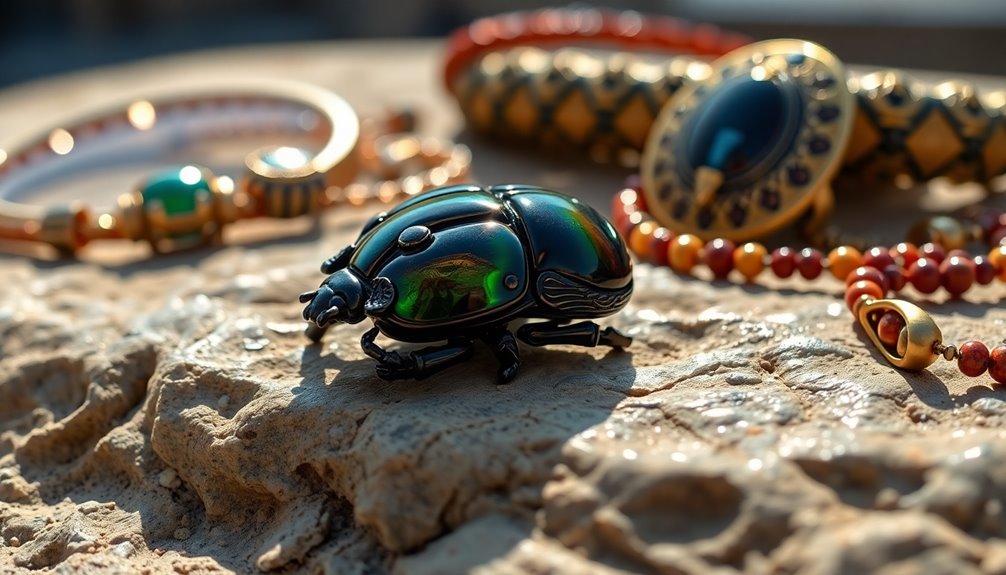
Today, you'll find scarab symbols in contemporary jewelry trends, where they're celebrated for their beauty and significance.
Many people wear these pieces as a token of good luck, connecting with the rich history behind the symbol.
This blend of ancient meaning and modern style shows how the scarab continues to resonate across cultures.
Contemporary Jewelry Trends
Scarab motifs have surged in popularity within contemporary jewelry trends, merging ancient symbolism with modern aesthetics.
Today's designers are creatively incorporating these iconic symbols into their pieces, reflecting both the spiritual significance of the scarab and contemporary tastes. You'll find stunning jewelry crafted from luxurious materials like gold and gemstones, such as tiger's eye, that resonate with the rich history of ancient Egyptian culture.
These designs often serve as more than just accessories; they function as protective amulets, appealing to a modern audience drawn to the scarab's associations with luck, transformation, and rebirth.
Scarab jewelry is particularly enchanting for those who appreciate vintage aesthetics, making it a sought-after choice for collectors.
Here are some key trends you might notice:
- Bold Statements: Large scarab rings and pendants that command attention.
- Layered Styles: Mixing scarab pieces with other jewelry for a unique look.
- Social Media Influence: Platforms like Instagram feature stunning designs, showcasing the blend of ancient mystique with contemporary fashion.
Additionally, the rise of personalized gifts has led to unique scarab designs that cater to individual tastes.
With these trends, the scarab remains a powerful symbol, bridging the gap between the past and present.
Symbol of Good Luck
While many symbols come and go in popularity, the scarab stands out as a timeless emblem of good luck, deeply rooted in ancient Egyptian culture. This powerful symbol represents protection and regeneration, drawing on its association with the sun god Khepri, who embodies the rising sun and rebirth.
In modern times, you might find scarab motifs in jewelry and fashion, reflecting a desire to connect with its historical significance while attracting positive energies.
Many people incorporate scarab imagery into their personal and spiritual practices, believing it enhances their resilience and ability to navigate life's challenges. The scarab's enduring popularity across various cultures illustrates its universal appeal as a symbol of luck.
Whether you wear it as a talisman or display it in your home, the scarab serves as a reminder of transformation and new beginnings.
As you explore the meanings behind the scarab, you may feel inspired to embrace its qualities of fortune and renewal. By doing so, you open yourself up to the possibilities of change and growth, inviting the spirit of the rising sun into your life.
Scarab Materials and Craftsmanship

In ancient Egypt, artisans expertly carved scarabs from a rich array of materials, including steatite, carnelian, and lapis lazuli, each chosen for its unique texture and color.
These skilled artisans utilized detailed carving techniques, employing tools like knives, gravers, and drills to create intricate designs that showcased their artistic creativity.
Scarabs varied in size and purpose, with heart scarabs averaging 7.5 cm in length, often crafted from nmhf-stone or other green stones, and adorned with gold settings to reflect their high religious importance.
The craftsmanship of these scarabs wasn't only functional but also symbolic.
Here are some notable materials and features of scarabs:
- Steatite: Soft and easily carved, perfect for detailed designs.
- Carnelian: A vibrant red stone, symbolizing life and liveliness.
- Lapis Lazuli: Deep blue and prized for its rarity, representing the heavens.
The decorative scarabs also featured diverse figures and animals, often highlighted by double rows of V-shaped incised lines on the underbody.
This attention to detail reflects the deep reverence ancient Egyptians had for scarabs and their meanings.
Archaeological Discoveries and Insights
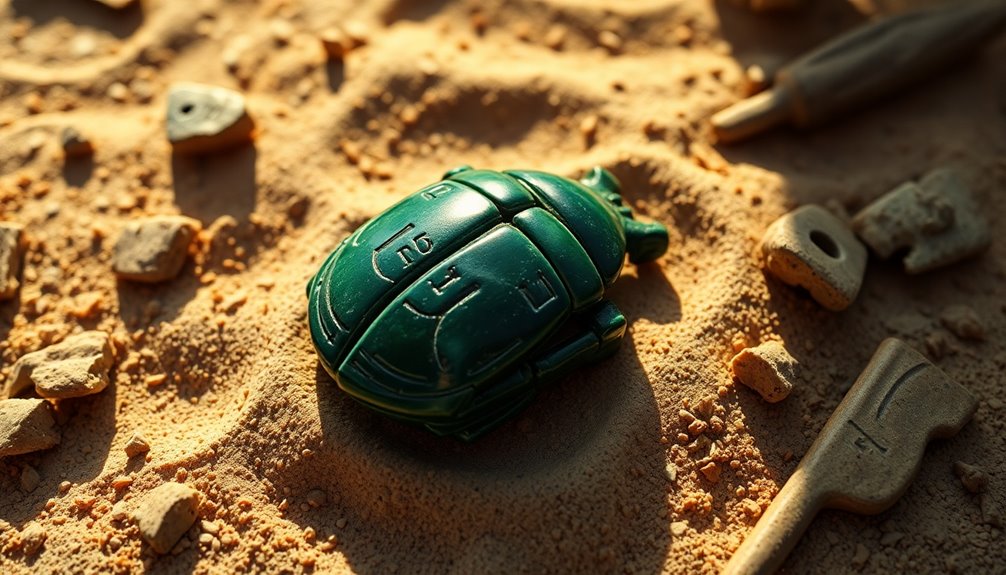
The rich craftsmanship of scarabs not only reflects artistic talent but also reveals their profound significance in ancient Egyptian culture. Archaeological discoveries date back to the Old Kingdom, showcasing scarabs as protective amulets and symbols of rebirth.
| Discovery Type | Significance | Notable Example |
|---|---|---|
| Heart Scarabs | Inscribed with spells for afterlife protection | Found in royal tombs |
| Ornate Artifacts | Showcase craftsmanship and status | Scarab of Hatshepsut |
| Scarab Seals | Used to secure documents and signify authority | Excavated in the Valley of Kings |
| Museum Collections | Provide insights into beliefs and societal values | McClung Museum exhibits |
| Tomb Discoveries | Highlight cultural beliefs in life after death | Numerous findings in burial sites |
These findings, like the heart scarabs, emphasize ancient Egyptians' deep beliefs in the afterlife. Scarab artifacts not only reveal the artistry of skilled artisans but also enhance your understanding of the values and practices that shaped ancient Egyptian society. The ongoing excavations continue to unveil the mysteries surrounding scarabs, linking them to the rich tapestry of their culture.
Frequently Asked Questions
What Does the Scarab Symbolize?
The scarab symbolizes regeneration and rebirth, deeply rooted in Ancient Egyptian culture.
You'll find it associated with the sun god Ra and the cycle of life. As you explore its significance, you'll discover that scarabs served as protective amulets, ensuring safe passage to the afterlife.
Their connection to transformation stems from the beetle's behavior of rolling dung balls, reflecting the continuous cycle of life and death, making the scarab a powerful symbol across cultures.
What Is the Power of Scarab?
The power of the scarab lies in its deep connection to regeneration and protection.
When you wear a scarab amulet, you're embracing its ability to guide you through life's challenges and changes. These ancient tokens not only symbolize the cycle of life and rebirth but also empower you spiritually.
What Is the Metaphor of the Scarab?
The scarab serves as a powerful metaphor for regeneration and rebirth in your life.
It represents the cyclical nature of existence, reminding you that just like the sun rises anew each day, you too can experience transformation.
When you wear or encounter scarab symbols, they encourage you to embrace change and navigate challenges, reinforcing the idea that every ending can lead to a new beginning.
Trust in this journey of renewal and growth.
What God Does the Scarab Represent?
Picture the warm glow of dawn breaking over the Egyptian horizon. That's the essence of the scarab, which represents the sun god Khepri.
When you think of Khepri, envision a powerful beetle rolling the sun across the sky, symbolizing rebirth and regeneration.
Khepri's influence is profound, connecting life cycles and the eternal soul. As you embrace this imagery, you realize the scarab's significance in ancient beliefs and its lasting impact on culture.
Conclusion
To summarize, the scarab symbol isn't just a relic of ancient Egypt; it's a powerful emblem that continues to inspire. Did you know that over 1,500 scarab artifacts have been unearthed in archaeological sites? This incredible number highlights their significance in history and culture. Whether you wear a scarab ring or admire its artistry, you're connecting with a tradition that spans millennia. Embrace the magic of the scarab, and let its energy enrich your life today.
